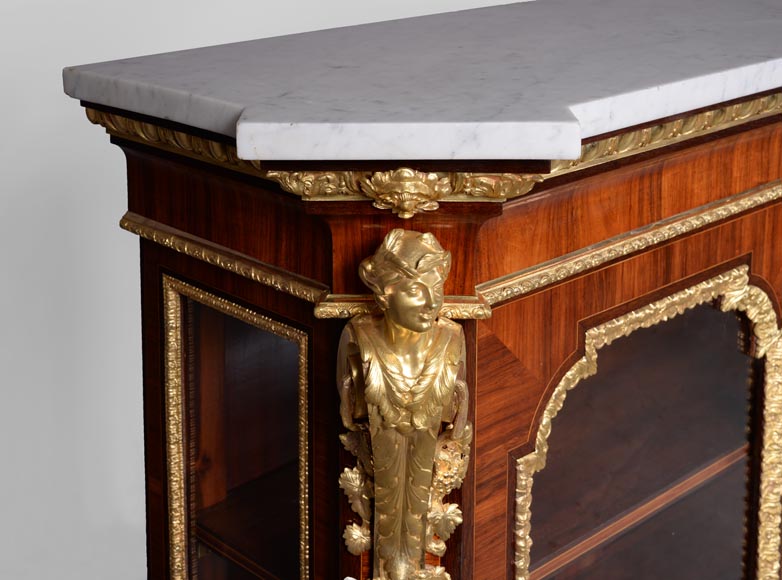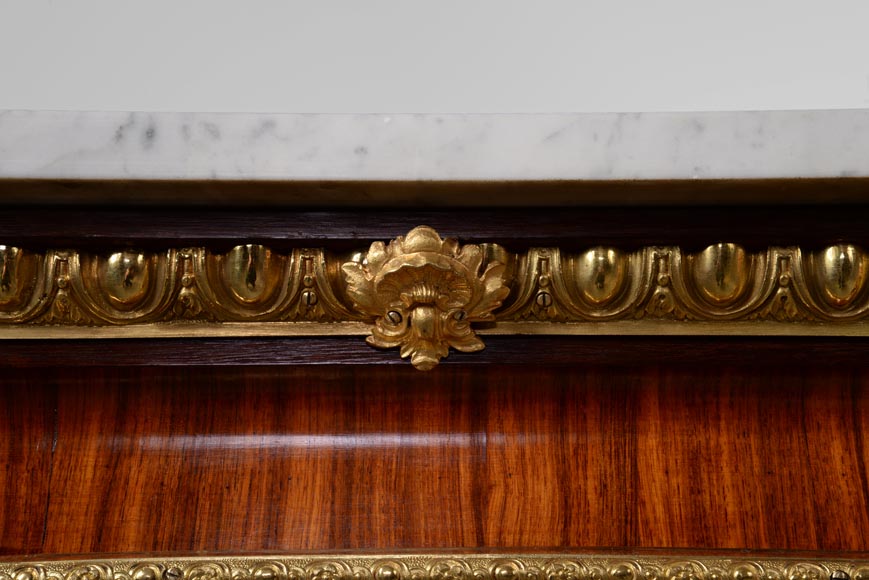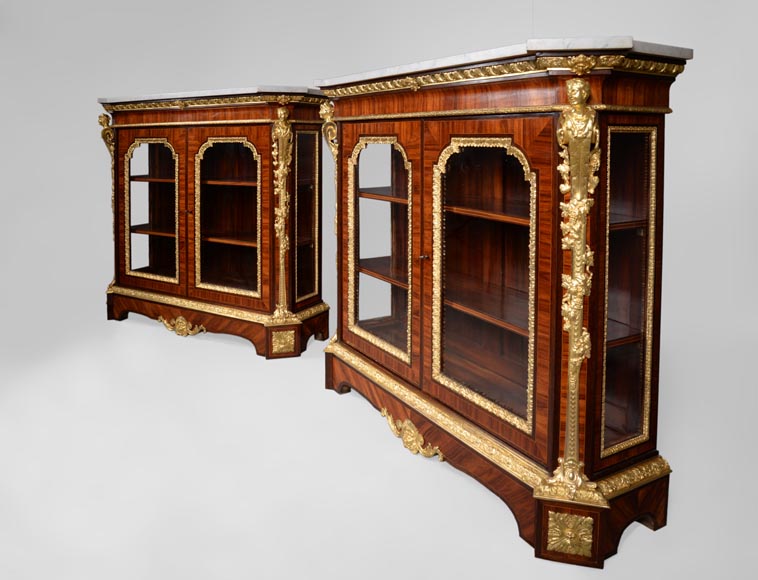Style Napoleon III / Ref.10638
Georges Alphonse MONBRO (attributed to), Pair of low bookcases with bronze espagnolettes
Dimensions
Width 50'' ⅜ 128cm
Height 43'' ¼ 110cm
Depth: 13'' ⅜ 34cm
Origin:
France, 19th century
Status:
In very good condition. Crack on the right window of the right cabinet.
This pair of cabinets with rosewood and amaranth veneer was made during the 19th century. Attributed to Georges Alphonse Bonifacio Monbro, these two pieces of furniture are characteristic of his work because of the delicacy and the profusion of the gilt and finely chiseled bronze decoration. The abundance of Monbro's production and his predilection for eclectic furniture enhanced the belief that Monbro made this cabinets.
Monbro, whose father was an antique dealer and a cabinetmaker, was born in 1807 in Paris, where he died in 1884. He took over the family business from 1838 with the name "Monbro aîné" and whose the shop was situated at 18, Rue Basse-du-Rempart. During Haussmann’s renovation of Paris, he had to move and set up in Rue du Helder, in the hôtel Dudon, which will also be demolished. Monbro sold curiosities, furnitures, bronzes, porcelains, tapestries, sculptures and was also cabinetmaker. He acquired a great renown and opened a branch in London around 1850. While his shop was compared by his contemporaries to a real antiquities museum, the furniture he created were famous thanks to their historicism and their eclecticism, in vogue, as this pair of cabinets.
The rosewood and amaranth veneer is very fine. The amaranth frames the rosewood parcels whose the streaks add ornamentation and relief, even a certain geometric aesthetic. Richly adorned with carved and gilt bronze, this cabinets each support a Carrara marble top subtly veined. On both sides, bronze and high relief espagnolettes adorn the corners. These espagnolettes, decorated with detailed leaves and draperies, are taken from the Regence style and are become, during Napoleon III, a recurring pattern in the decorative arts. Leaves and bunches of grapes surround the bronze borders as a vine stock. The furniture legs are inspired both by Louis XV and Louis XVI styles : they are ornated with square rosettes which are overhung by rococo curves and shells. A half-lion and half-human face is at the centre and is wrapped with foliage. The bronze is very fine and elaborated, especially on the edgings with rococo decorations which structure each piece of wood or on the edgings finely decorated with oak leaves which frame the two windows.
Both restorer and cabinetmaker renowned for his skill as connoisseur about bronzes and antique furnitures, Monbro specialized in historical styles and in antique furnitures reproduction, at a time when copies were most appreciated than originals. Constance Aubert tells in the review L'Opéra in 1842 his journeys through France, Switzerland and Italy for visiting all the castles to find antique furnitures in order to resell or to copy it for his creations. However, if Monbro was a real historic styles expert – Marc Fournier, a critic, writes in the review La Grande ville, that he was "the only curiosities merchant with [...] a great reputation and genuinely versed in the science of archeology" - he did not imitate originals, but he reinterpreted historic styles, according to the trend of the period, and this pair of cabinets is a perfect example : Louis XV, Louis XVI and Napoleon III styles are mixed.
Georges Alphonse Bonifacio Monbro is especially known for his ebony and gilt bronze furnitures decorated with enamel such as the one currently exhibited at the Musée d'Orsay. Two caryatids also adorn the angles and the figure in the center is reminiscent of those at the bottom of our cabinets. This furniture with many inspirations - rigor and egyptomania are taken from the Napoleon I style, shells and curves from the Louis XV style, square rosettes from the Louis XVI style - is also characteristic of the furniture of the time.
Antiques merchant, with whom "all the precious remains of past ages are," Monbro made bronze furnitures with eclectic decor his specialty, symptomatic of the aestethic of the second half of the 19th century and his taste for curiosities.
Informations
Price: on request
Recommended for you :
Dimensions:
Width: 67
Height: 203
Depth: 32
Dimensions:
Width: 110
Height: 173
Depth: 44
Dimensions:
Width: 85
Height: 150
Depth: 43
Dimensions:
Width: 258
Height: 85
Depth: 144
Dimensions:
Width: 141
Height: 73
Depth: 70
Dimensions:
Width: 32
Height: 59
Depth: 22
Dimensions:
Width: 275
Height: 109
Depth: 155
Dimensions:
Width: 71
Height: 167
Depth: 37
Dimensions:
Width: 130
Height: 182
Depth: 24
Dimensions:
Width: 124
Height: 148
Depth: 47
Dimensions:
Width: 128
Height: 218
Depth: 44
Dimensions:
Width: 53
Height: 138
Depth: 34





























